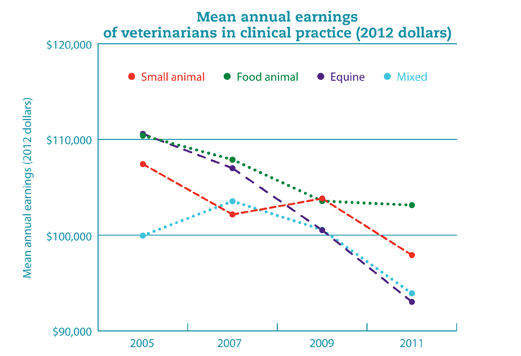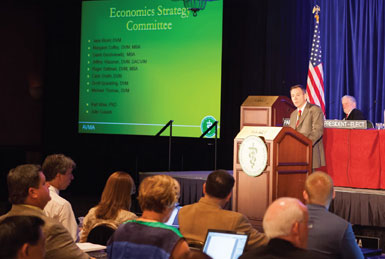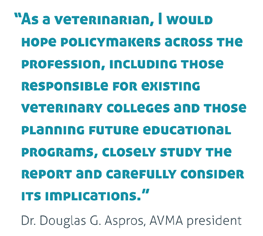Service surplus
Approximately 12.5 percent of veterinary services in the United States went unused last year, according to a new AVMA study. The study further projects double-digit underutilization of veterinary labor over the next decade.
The demand for veterinary services in 2012 was sufficient to fully employ just 78,950 of the 90,200 veterinarians currently working in clinical and nonclinical settings, resulting in an underuse of services equal to the labor of 11,250 veterinarians, study results show.
Moreover, the nation’s veterinary services capacity is likely to be underutilized by 11 to 14 percent through 2025, or the equivalent of an underemployment of as many as 12,300 veterinarians annually. The U.S. Veterinary Workforce Study offers a measure of excess capacity in the veterinary profession, a condition in which demand for veterinary services is less than the available supply of those services at prevailing prices. On April 23, the AVMA released its final report on the study, which found excess capacity highest among equine practices, followed by small animal practices, food production practices, and mixed animal practices.
Michael Dicks, PhD, director of the AVMA Veterinary Economics Division and a study consultant, said excess capacity is present in every industry and is necessary to meet surges in demand. “What we don’t know is the optimum level of excess capacity for veterinary medicine, that is, meeting the demands of society and the profitability of the practice,” Dr. Dicks said. “Thus, it is difficult to say for certain from the current measure of excess capacity what this means about the health of the veterinary industry.”

A former agricultural economist, Dr. Dicks cautioned against reading too much into the finding that 12.5 percent of veterinary services were unused. “The estimate’s not really saying that there are 11,250 veterinarians who can’t find work. What it is saying is that a majority of private practitioners don’t feel like their capacity to provide services is being fully utilized,” he said.
Veterinarians are largely self-employed and work in an industry with relatively low unemployment, leading researchers to conclude that excess capacity has manifested as underemployment, not out-of-work veterinarians. Identifying the causes of the underutilization of veterinary services was not a goal of the AVMA study.
Additional study findings include a decline in the inflation-adjusted mean income for veterinarians in clinical practice from 2005-2011, most notably in the equine sector. On average, veterinarians employed in clinical practice are working more than 40 hours a week, despite the excess capacity in the workforce generally. Women, who constitute about half the current veterinary labor force, will likely make up 71 percent of the profession by 2030.
Market influences on the veterinary industry have been analyzed periodically since the mid-1980s. Prior to the AVMA study, the most recent study was conducted by the National Research Council, which published its assessment of veterinary workforce needs in 2012, four years later than promised (see JAVMA, July 15, 2012).
Last year, the AVMA Executive Board commissioned IHS Healthcare & Pharma and the Center for Health Workforce Studies at the State University of New York to conduct an economic analysis of the current and future supply of and demand for veterinarians and veterinary services in the United States. It was part of a broad initiative by the AVMA to support the veterinary workforce.

“When we say there’s 12.5 percent excess capacity in the system, we can take that as a reliable finding. What we don’t know is what that means from a practical point of view for the various sectors of the profession,” AVMA President Douglas G. Aspros said, adding that the Association is committed to studying the issue further.
“As a veterinarian, I would hope policymakers across the profession, including those responsible for existing veterinary colleges and those planning future educational programs, closely study the report and carefully consider its implications,” Dr. Aspros said.
The AVMA describes its workforce study as the beginning of a long-term process to better understand the U.S. market for veterinary labor and services—no easy task, given the broad range of veterinary disciplines and a general lack of reliable employment data for the profession. Notably, the NRC research committee cited the latter for the delay in the release of its study.
For the AVMA study, researchers conducted literature reviews, data and survey analyses, and interviews with stakeholders and subject experts. Educated assumptions were made when information wasn’t available. The researchers accounted for such variables as entrants to the veterinary workforce, retirement patterns, work hours, and geographic distribution of veterinary services.
A survey of veterinarians employed in clinical practice was conducted in conjunction with the study and found nearly half the respondents thought their local market was inundated by veterinarians and veterinary practices. A similar percentage reported a perception of just the right numbers of both veterinarians and veterinary practices. Just over half perceived their practices were not working at full capacity.

A key component of the workforce study was the development of a computer simulation model that could be used to estimate current and future excess capacity in the veterinary workforce. The AVMA Veterinary Economics Division will refine and update the model as research gaps related to the market for veterinary labor and services are identified and filled.
Dr. Link Welborn chairs the AVMA Workforce Advisory Group created to supervise the research process. The Veterinary Workforce Study is a starting point, he explained, and the estimates and projections will be revised as new data become available.
“The excess capacity estimates are indeed that: estimates based on the best available data. Accordingly, one could argue that the estimates are a little high or a little low, but the Workforce Advisory Group has a high level of confidence that substantial excess capacity does exist within certain employment sectors and geographic regions,” Dr. Welborn said.

The study estimates that at the beginning of 2012, the total supply of U.S. veterinary labor was 90,200 (measured as full-time equivalent veterinarians) while demand equaled the services of 78,950 veterinarians, creating an excess capacity of 12.5 percent, or the equivalent of 11,250 veterinarians. Demand for veterinary services would have had to increase 14 percent to fully employ the entire veterinary workforce last year.
The study goes on to project 11 percent growth in both areas over the coming years, reaching a veterinary labor supply totaling 100,400 and service demand equal to 88,100 veterinarians by 2025. As a result, excess capacity in veterinary services is expected to range from 11 percent to 14 percent each year between 2012 and 2025.
Researchers explain they modeled the sensitivity of the supply projections to changes in underlying assumptions regarding the number of veterinarians trained, work patterns, and retirement patterns. Under every scenario, they saw the supply projections exceed demand through 2025.
“Given the high debt load of new students and stagnating incomes seen in recent years among veterinarians, it is unlikely that veterinarians will reduce average hours worked or retire earlier than current and historical patterns,” the study states. “Consequently, there is greater potential for the supply projections to exceed the baseline estimates rather than fall short of the baseline estimates.”

In addition to the workforce study report, the AVMA released a report from the Workforce Advisory Group regarding the study’s implications for the veterinary profession. In it were 11 recommendations for actions the Association and the veterinary profession could undertake in response to the study report, including identifying ways to boost the demand for veterinary services, researching the relationship between the demand for veterinary services and the U.S. economy as a whole, and evaluating the effects of price sensitivity and changes in consumers’ disposable income on demand.
In the meantime, veterinarians can act now to boost productivity in their practices, according to Dr. Welborn. “One of the best opportunities for all veterinarians is to focus on increasing the demand for veterinary services by educating consumers of those services about the true importance and value of veterinary care,” he said. “While the Partners for Healthy Pets initiative only applies to small animal practice, it is an excellent example of tools that can be utilized to enhance consumer awareness.”
The 2013 U.S. Veterinary Workforce Study is available at www.avma.org. An executive summary of the study and the AVMA Workforce Advisory Group report are published in this issue of JAVMA (see article and article).